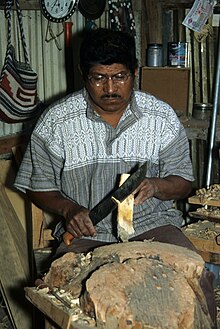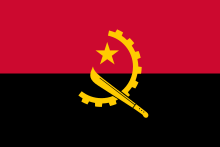



A machete (/məˈʃɛti/; Spanish pronunciation: [maˈtʃete]) is a broad blade used either as an agricultural implement similar to an axe, or in combat like a long-bladed knife. The blade is typically 30 to 66 centimetres (12 to 26 in) long and usually under 3 millimetres (1⁄8 in) thick. In the Spanish language, the word is possibly a diminutive form of the word macho, which was used to refer to sledgehammers. Alternatively, its origin may be machaera, the name given by the Greeks and Romans to the falcata. It is the origin of the English language equivalent term matchet, though this is rarely used. In much of the English-speaking Caribbean, such as Jamaica, Barbados, Guyana, Grenada, and Trinidad and Tobago, the term cutlass is used for these agricultural tools.
Uses
Agriculture
In various tropical and subtropical countries, the machete is frequently used to cut through rainforest undergrowth and for agricultural purposes (e.g. cutting sugar cane). Besides this, in Latin America a common use is for such household tasks as cutting large foodstuffs into pieces—much as a cleaver is used—or to perform crude cutting tasks, such as making simple wooden handles for other tools. It is common to see people using machetes for other jobs, such as splitting open coconuts, yard work, removing small branches and plants, chopping animals' food, and clearing bushes.
Machetes are often considered tools and used by adults. However, many hunter–gatherer societies and cultures surviving through subsistence agriculture begin teaching babies to use sharp tools, including machetes, before their first birthdays.
Warfare
People in uprisings sometimes use these weapons. For example, the Boricua Popular Army are unofficially called macheteros because of the machete-wielding laborers of sugar cane fields of past Puerto Rico.
Many of the killings in the 1994 Rwandan genocide were performed with machetes, and they were the primary weapon used by the Interahamwe militias there. Machetes were also a distinctive tool and weapon of the Haitian Tonton Macoute.
In 1762, the British captured Havana in a lengthy siege during the Seven Years' War. Volunteer militiamen led by Pepe Antonio, a Guanabacoa councilman, were issued with machetes during the unsuccessful defense of the city. The machete was also the most iconic weapon during the independence wars in Cuba, although it saw limited battlefield use. Carlos Manuel de Céspedes, owner of the sugar refinery La Demajagua near Manzanillo, freed his slaves on 10 October 1868. He proceeded to lead them, armed with machetes, in revolt against the Spanish government. The first cavalry charge using machetes as the primary weapon was carried out on 4 November 1868 by Máximo Gómez, a sergeant born in the Dominican Republic, who later became the general in chief of the Cuban Army.
The machete is a common side arm and tool for many ethnic groups in West Africa. Machetes in this role are referenced in Chinua Achebe's Things Fall Apart.
Some countries have a name for the blow of a machete; the Spanish machetazo is sometimes used in English. In the British Virgin Islands, Grenada, Jamaica, Saint Kitts and Nevis, Barbados, Saint Lucia, and Trinidad and Tobago, the word planass means to hit someone with the flat of the blade of a machete or cutlass. To strike with the sharpened edge is to "chop". Throughout the English-speaking islands of the Caribbean, the term 'cutlass' refers to a laborers' cutting tool.
The Brazilian Army's Instruction Center on Jungle Warfare developed a machete-style knife with a blade 25 cm (10 in) in length and a very pronounced clip point. This machete is issued with a 13 cm (5 in) Bowie knife and a sharpening stone in the scabbard; collectively called a "jungle kit" (Conjunto de Selva in Portuguese); it is manufactured by Indústria de Material Bélico do Brasil (IMBEL).
The machete was used as a weapon during the Mau Mau rebellion, in the Rwandan Genocide, and in South Africa, particularly in the 1980s and early 1990s when the former province of Natal was wracked by conflict between the African National Congress and the Zulu-nationalist Inkatha Freedom Party.
Manufacture
Good machetes rely on the materials used and the shape. In the past, the most famous manufacturer of machetes in Latin America and the Spanish-speaking Caribbean was Collins Company of Collinsville, Connecticut. The company was founded as Collins & Company in 1826 by Samuel W. Collins to make axes. Its first machetes were sold in 1845 and became so famous that a machete was called un collin. In the English-speaking Caribbean, Robert Mole & Sons of Birmingham, England, was long considered the manufacturer of agricultural cutlasses of the best quality. Some Robert Mole blades survive as souvenirs of travellers to Trinidad, Jamaica, and, less commonly, St. Lucia.
Colombia is the largest exporter of machetes worldwide.
Cultural influence

The flag of Angola features a machete, along with a cog-wheel.
The southern Brazilian state of Rio Grande do Sul has a dance called the dança dos facões (machetes' dance) in which the dancers, who are usually men, bang their machetes against various surfaces while dancing, simulating a battle. Maculelê, an Afro-Brazilian dance and martial art, can also be performed with facões. This practice began in the city of Santo Amaro, Bahia, in the northeastern part of the country.
In the Philippines, the bolo is used in training in eskrima, the indigenous martial art of the Philippines.
In the Jalisco region of Mexico, Los Machetes is a popular folk dance. This dance tells the story of cutting down sugar cane during the harvest. Los Machetes was created by Mexican farm workers who spent a great amount of time perfecting the use of the tool, the machete, for harvesting. Traditionally, real machetes are used while performing this dance.
Similar tools
The panga or tapanga is a variant used in East and Southern Africa. This name may be of Swahili etymology; not to be confused with the panga fish. The panga blade broadens on the backside and has a length of 41 to 46 cm (16 to 18 in). The upper inclined portion of the blade may be sharpened.
Other similar tools include the parang and the golok (from Malaysia and Indonesia); however, these tend to have shorter, thicker blades with a primary grind, and are more effective on woody vegetation.
The tsakat is a similar tool used in Armenia for clearing land of vegetation.
Other similar tools include:
References
- "Online Etymology Dictionary". etymonline.com. Retrieved 10 December 2016.
- "La falcata ¿mito romántico o realidad? - Archivos de la Historia". 8 April 2020.
- Es, Armas. "El Machete: Abriéndose paso en jungla y combate - Mundo Armas".
- "matchet". Dictionary/thesaurus. The Free Dictionary. Retrieved 7 February 2009.
- Blair, Teresa P. A-Z of Jamaican Patois (Patwah), Page 49, Google Books Result
- Klein, John (21 October 2013). "What Is a Machete, Anyway?". The Atlantic. Retrieved 15 January 2015.
- ^ Franz, Carl; Havens, Lorena (2012). Rogers, Steve; Rogers, Felisa Churpa Rosa (eds.). The People's Guide to Mexico (14th ed.). Berkeley, Calif.: Avalon Travel. pp. 277–278. ISBN 978-1-61238-049-0.
- Day, Nicholas (9 April 2013). "Give Your Baby a Machete". Slate. Retrieved 19 April 2013.
- Martin, Gus (15 June 2011). The SAGE Encyclopedia of Terrorism, Second Edition. SAGE Publications. p. 490. ISBN 978-1-4129-8016-6.
- Verwimp, P. (2006). "Machetes and Firearms: the Organization of Massacres in Rwanda". Journal of Peace Research. 43 (1): 5–22. doi:10.1177/0022343306059576.
- Braid, Mary (3 March 1999). "The Jungle Massacre: African rebels who revel in their machete genocide". The Independent. Archived from the original on 12 January 2018. Retrieved 6 February 2009.
- "Tonton Macoute". Haiti History. Haitian Media. Archived from the original on 3 January 2013. Retrieved 6 February 2009.
- Ponce, Mildrey (2007). "Why Did The English Take Over Havana?". Cuba Now. Archived from the original on 14 July 2014. Retrieved 6 February 2009.
- Tone, John Lawrence (2006). "Chapter 10: Mal Tiempo and the Romance of the Machete". War and Genocide in Cuba, 1895–1898. University of North Carolina Press. pp. 126–127. ISBN 978-0-8078-3006-2.
- Gravette, A G (28 September 2007). "Chapter 7: The Southern Peninsula". Cuba (5the ed.). New Holland Publishers. p. 106. ISBN 978-1-84537-860-8.
- "Major General Máximo Gómez Báez". Revolutionary Armed Forces. Gobierno de la Republica de Cuba. Archived from the original on 4 March 2016. Retrieved 6 February 2009.
- "Plot Overview". Things Fall Apart. SparkNotes. Retrieved 6 February 2009.
- Sturges, James Walter (August 2010). Machetes in the Trunk: Three Weeks in Panama. James Sturges. p. 31. ISBN 978-1-4404-8664-7.
- ^ Allsopp, Richard (2003). Dictionary of Caribbean English Usage. University of the West Indies Press. pp. 184, 442–443. ISBN 978-976-640-145-0.
- "Conjunto de Selva". Produtos. Indústria de Material Bélico do Brasil. Archived from the original on 29 April 2021. Retrieved 20 February 2012.
- Cavaleri, David P. (2005). The Law of War: Can 20th Century Standards Apply to the Global War on Terrorism?. DIANE Publishing. p. 66. ISBN 978-1-4379-2301-8.
- Jones, Chester Lloyd (1906). The Consular Service of the United States: Its History and Activities. Philadelphia: University of Pennsylvania Press. p. 72.
- Kauffman, Henry J. (1994). "III: The Nineteenth Century". American Axes: A Survey of Their Development and Their Makers. Masthof Press. p. 30. ISBN 978-1-883294-12-0.
- Henry, Daniel Edward (1995). Collins' Machetes and Bowies, 1845-1965. Krause Publications. p. 15. ISBN 978-0-87341-403-6.
- La Farge, Oliver (1956). A Pictorial History of the American Indian. Crown Publishers. p. 219.
- "1566: Vintage Trinidad Machete in Leather Sheath : Lot 1566". liveauctioneers.com. Retrieved 10 December 2016.
- "Colombia líder – La Prensa". laprensa.com.ni. 12 April 2014. Archived from the original on 14 April 2014. Retrieved 1 May 2018.
- Lewis, John Lowell (1992). "3: Capoeira in Salvador". Ring of Liberation: Deceptive Discourse in Brazilian Capoeira. University of Chicago Press. pp. 54–55. ISBN 978-0-226-47683-4.
- Wilson, Frederick T. (1 January 2004). A Sailor's Log: Water-tender Frederick T. Wilson, USN, on Asiatic Station, 1899–1901. Washington: Kent State University Press. p. 130. ISBN 978-0-87338-782-8.
- "Los Machetes - Folk Dance Fun!". Sally's Sea of Songs. Retrieved 16 March 2024.
- Mothander, Björn; Finn Kjærby; Kjell J. Havnevik (1989). Farm Implements for Small-scale Farmers in Tanzania. Nordic Africa Institute. pp. 36–37. ISBN 978-91-7106-290-1.
- Stone, George Cameron; Donald J. LaRocca (1999). A Glossary of the Construction, Decoration, and Use of Arms and Armor in All Countries and in All Times: In All Countries and in All Times. Courier Dover Publications. pp. 481–482. ISBN 978-0-486-40726-5.
- Stone, George Cameron; Donald J. LaRocca (1999). A Glossary of the Construction, Decoration, and Use of Arms and Armor in All Countries and in All Times: In All Countries and in All Times. Courier Dover Publications. p. 249. ISBN 978-0-486-40726-5.
External links
 Media related to Machetes at Wikimedia Commons
Media related to Machetes at Wikimedia Commons
| Forestry tools and equipment | ||
|---|---|---|
| Tree planting, afforestation |
|  |
| Mensuration | ||
| Fire suppression | ||
| Axes |
| |
| Saws | ||
| Logging | ||
| Other | ||
| ||